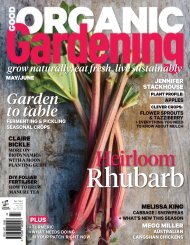1. Good Organic Gardening - January-February 2016
1. Good Organic Gardening - January-February 2016
1. Good Organic Gardening - January-February 2016
You also want an ePaper? Increase the reach of your titles
YUMPU automatically turns print PDFs into web optimized ePapers that Google loves.
A plant with attitude<br />
Stinging nettle / Urtica spp.<br />
Why would you grow something with “sting” in its<br />
name? Because it has a multitude of health benefits,<br />
tastes good and grows like a weed<br />
Words Kerry Boyne<br />
There’s hardly a weed that hasn’t been<br />
used as food by someone, somewhere.<br />
Fennel, which grows in wild profusion<br />
all over Sicily, its bright yellow flowers<br />
a harbinger of spring, is central to Sicilian cuisine.<br />
The Cretans use everything from endives and<br />
beet leaves to wild rocket and dandelion greens<br />
in their cooking. Other weeds commonly used as<br />
food include wild celery, watercress, purslane and<br />
borage. And then there’s nettle.<br />
Familiarly known as stinging nettle — the<br />
fluid in the barb-like hairs on its leaves and stem<br />
can inflict a temporary sting — nettle occurs in<br />
Australia as native scrub nettle (Urtica incisa)<br />
and in introduced European varieties U. dioica<br />
(large leaf) and U. urens (small leaf).<br />
The sting is intense but short-lived and can<br />
be relieved by the application of the juice of the<br />
plant itself, though that may involve more stings.<br />
Calamine lotion or even urine can help. The<br />
stinging hairs, or trichomes, are neutralised by<br />
cooking or drying.<br />
Like any self-respecting weed, nettle will<br />
quickly colonise a fertile area such as a cow<br />
paddock and its presence is a sure indication of<br />
good soil. Livestock won’t eat this nutritious crop,<br />
however, probably because of the sting. They<br />
don’t know what they’re missing.<br />
Nettle attracts moths and butterflies, which<br />
feed on it during the larval stage, and is said to<br />
repel flies as well as have a beneficial effect on<br />
other plants such as fruiting trees.<br />
In northern Europe, nettle — like flax and<br />
hemp — was once widely used as a thread to<br />
make everything from clothes to sails and can<br />
even produce green and yellow dyes. Due to a<br />
cotton shortage, it was used to make uniforms<br />
for the German army during the Great War; more<br />
recently, in some European countries, it’s starting<br />
to make a comeback as a textile.<br />
Culinary uses<br />
Nettle is high in vitamins A, C, D and potassium,<br />
manganese and calcium, with more iron than<br />
spinach, to which it has a similar taste. It can<br />
be used in pesto, soups and purees, added to<br />
polenta and smoothies, decocted as a tea or<br />
cordial and, in parts of rural Britain, even brewed<br />
as beer.<br />
The plant is also used in some cheeses,<br />
such as Gouda and Cornish Yarg, as part of<br />
the filling (along with other greens) in Albanian<br />
börek and in some northern Indian, Kashmiri<br />
and Nepalese dishes.<br />
It’s best to use the young leaves before the<br />
plant flowers and sets seed. By then the leaves<br />
may develop tiny gritty calcium carbonate<br />
particles called cystoliths, which can irritate the<br />
uninary tract and even damage the kidneys.<br />
Medicinal uses<br />
Nettle’s history as a folk medicine is long and<br />
diverse. In ancient Greece it was prescribed as a<br />
laxative and diuretic and even today its roots are<br />
approved by the German Commission E as<br />
a remedy for UTIs and prostate conditions. It may<br />
also assist as a blood, liver and kidney tonic.<br />
Aside from the roots, the parts above ground<br />
have been used to treat kidney stones, urinary<br />
complaints, allergies, hay fever, osteoarthritis,<br />
diabetes and poor circulation. It can be applied<br />
as a poultice for muscle aches or used as a<br />
conditioner to control dandruff.<br />
Nettle Tea<br />
Place about 12 fresh leaves (thoroughly<br />
washed first) or a tablespoon of dried<br />
leaves in 1L of water. Bring to the boil<br />
and simmer for about 15 minutes. Strain<br />
and add honey if desired. Serve hot or<br />
refrigerate and drink cold.<br />
Shutterstock<br />
20 | <strong>Good</strong> <strong>Organic</strong> <strong>Gardening</strong>
















